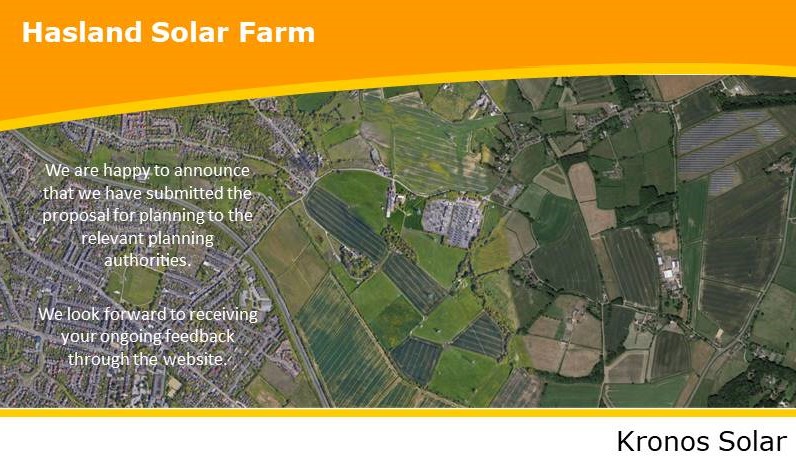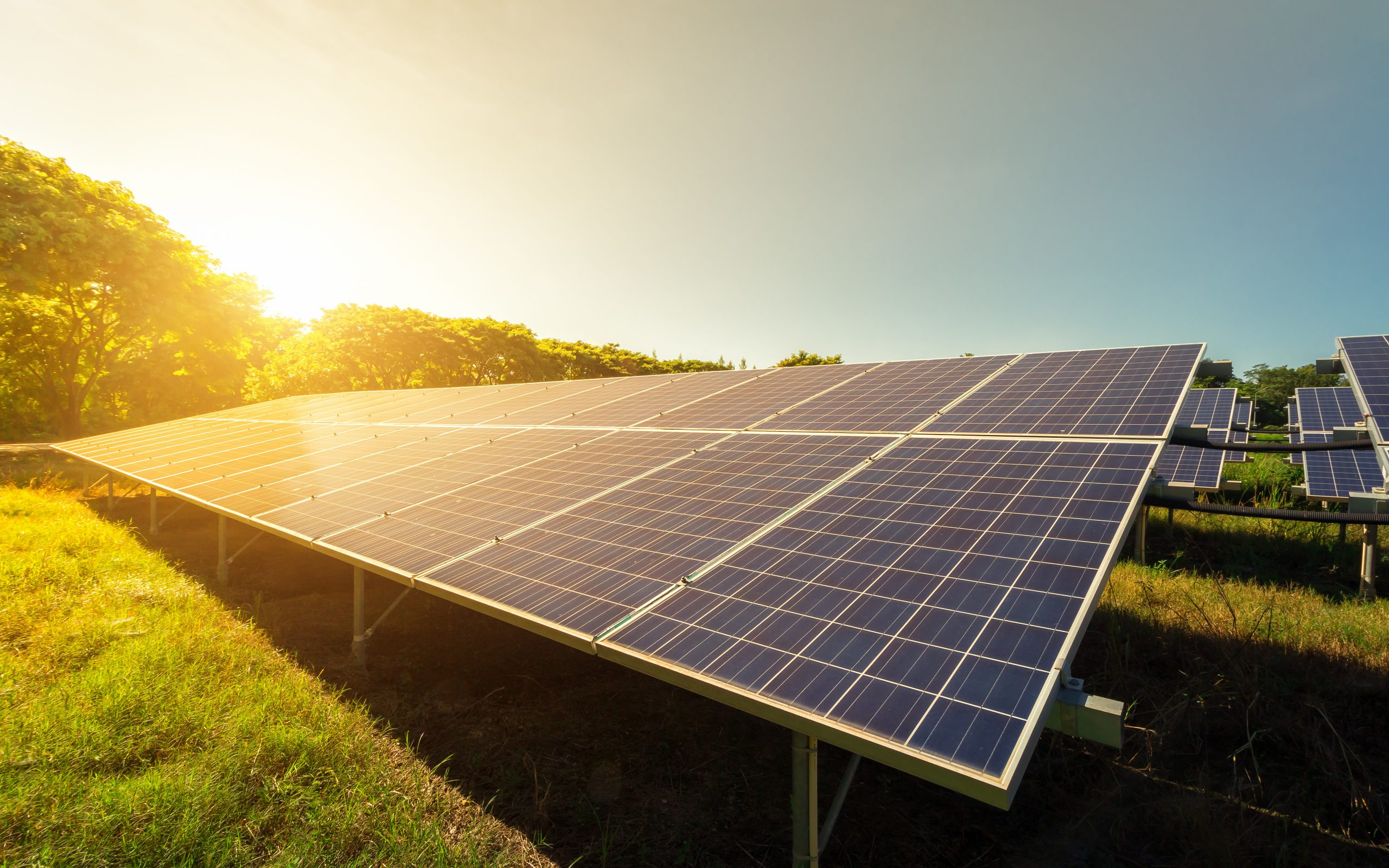About the Solar Park
The Council has set the ambitious target of significantly increasing the share of renewable energy sources in the future. This is in line with local, national and international targets set in an attempt to reduce our dependence on fossil fuels and, thus, combat global warming.
A solar park is permitted for a maximum period of 40 years. After this period, the site of the solar park will be cleaned up and the land will be given back its former use.
A ground-based solar park offers opportunities to enhance the environment around it through appropriate mitigation measures. Preservation of the land through low disturbance of the ground is only one side of the coin. With a solar farm, the opportunity to plant a species-rich mix of grassland arises. This not only enhances the biodiversity of the terrain, which is usually comprised of a poor grassland monoculture, but it provides foraging opportunities for animals in the surrounding ecosystem. This also applies to the vegetation around the solar park, such as hedges and trees, which are more sensibly managed providing additional shelter for the local fauna and flora.
Renewable energies are becoming an integral part of the English landscape and its society, and its depolyment will increase even more in the future. Having a solar farm fully integrated into the landscape not only has the benefit of locally produced green electricity, but it provides the surrounding community with a sense of pride thanks to their active contribution to the national goals of clean energy generation.
We look forward to hearing your suggestions and comments on how to best integrate the solar park into the proposed setting.

The panels will be placed at a maximum height of 2.6 to 3 metres.
The Hasland Solar Farm has a capacity of approximately 49.9 Megawatts. That is equivalent to clean energy supply for approximately 11,500 households. The energy generated will be fed into the national electricity grid.
The landscaping and natural integration of this project requires the installation of multiple fences and the planting of hedges, both new ones and reinforcement of already present vegetation. To secure the solar park, the site boundaries will be fenced with a deer fence that is separated from the solar panels by 3 metres and allows for a maintenance path. The fence is required to prevent theft and destruction of the solar panels as much as possible and is a requirement of the insurance company.

Pre-application request:
The council makes an initial revision of the project and suggests the scope of the detailed studies that are necessary for the future submission of the application.
Stakeholder consultation:
By means of personal conversations, a walk-in evening and reactions via this website, Kronos Solar provides an open space to discuss how the plan will fit in with the landscape and how it will be designed. This may include comments about, for example, screening and visibility of the park, the layout of the solar farm, the construction of the driveway and the wishes for ecological improvements at the location. Together with a landscape architect, the (technical) possibilities can be examined. Overall, the aim is to minimise the impact on the surroundings. Following the public consultation, adjustments will be incorporated into the plan.
Planning permission:
After Kronos Solar puts together the required documentation and reviews the comments of the local community, the Council will examine whether the proposal meets all the requirements and fits into the policy plans. The project is validated, after which it is available for public inspection. If there are no objections during the 6-week judicial review period, the municipality issues a decision, after which the permit is granted.
Construction phase:
As soon as the financing has been arranged and all the contracts with suppliers have been concluded, the construction phase can begin.
The construction of the solar park will take about six months. During these months various construction stages will be completed, starting with the installation of the fencing and the internal infrastructure, the delivery of the materials on site and the setting up of the (temporary) building security system. After that, the installation of the substructure takes place and finilizes with the installation of the panels. Finally, the cabling for the electrical connection is laid. Parallel to this, the grid manager will work on the connection work in and around the customer station.
These various phases ensure that the inconvenience caused by the construction is minimal and it is also accompanied by a traffic management plan to avoid disruptions to the local highway network.
Operational phase:
Upon completion of the project, the solar farm becomes operational. The sustainably generated electricity is supplied to customers via the public electricity grid and actively constributes to the national Net Zero Target. Kronos Solar will have the ecological management carried out by a professional organisation and technical any faults will be resolved as soon as possible by appointed professionals as well. Controlled pasture management and rainfall will help in the upkeep of the park and on-site mainatainance will occur only a few times per year.
Dismantling:
After 40 years, the solar park will be dismantled and the plots of land will be delivered in their original state. For this purpose, Kronos Solar will instruct an organisation that focuses entirely on the sustainable dismantling and recycling of (used) solar panels.
The exact cable route is determined by the network operator and agreed with the Council prior to construction. The network operator applies for a separate licence for this.
Kronos Solar is a German company with international operations. We have been a stable player in the deployment of large-scale solar farm projects for many years with a proven track record. We have experience developing ground-based solar parks on pasture, fallow land and former industrial areas.
We are one of the fastest growing developers in the market and are currently active on 4 continents, in 9 different countries. Other than the UK, we are also active in France, Germany and the Netherlands. We pride in our portfolio of over 60 developed projects and have a success rate in obtaining the planning permission of more than 90%.
Kronos’ success is based on a direct connection with the local stakeholders of our projects and a keen eye for quality and cost-effectiveness. As an independent developer, Kronos Solar is able to combine the most suitable locations, technologies and partners to realise responsible, sustainable, solar energy projects.
Due to the complexity of the projects, Kronos Solar chooses to be involved from A to Z, paying a lot of attention to cooperation with local parties and a sustainable integration of the landscape in order to create added value for the environment.
You can find more information on our website.
The best way to contact us is via the contact form on this website.
The targets for the generation of renwable energy are very ambitions and we need to pick up the pace. The United Kingdom wants to reduce its emissions by 80% by 2050 and solar photovoltaics has an important role to play: 80GW need to be installed in the next 40 years and every council needs to play its part. A solar park of this size will enable the Council to take a major step towards achieving these objectives.
About Solar Farms
Solar panels are designed with a special coating to absorb the sun’s rays. This means that reflection in the form of glint and glare is avoided as much as possible by design, since it would otherwise lead to a potential loss of energy. A comparative study of common reflective surfaces shows that solar panels reflect less light than, for instance, steel, standard glass or plastic. The reflection of a solar panel is comparable to that of smooth water.
Any remanent reflection is minimal and only occurs at a fixed angle in relation to the solar panels. The time the sun shines on the solar panels at this angle is very short during the day and not all days throughout the year. In addition, landscaping such as a hedges around the solar park can prevent any remaining glare that could cause a nuisance in the surrounding area.
A solar park produces virtually no noise. The solar panels themselves do their work silently. The inverters that convert the direct current from the solar panels to alternating current for the electricity grid are available without fans. The transformer needed at a solar park produces a light buzz as soon as the sun shines its brightest in the middle of the day, but this quickly fades away from background noise in the surrounding area. Given the distance between the intended solar park and homes in the area, we expect that local residents will not be able to hear the solar park from their homes.
Kronos Solar takes great care in revising multiple elements for a proposed location of a solar farm. Examples of the criteria we take into consideration are the distance from the site to nearby residential premises, existing designations of the land, ground characteristics, size of the land, presence of grid connection and the current use of the terrain. Additionally, it is imperative that the solar irradiation at the location is optimal for the efficient production of energy per square meter.
A solar park or a solar farm is a piece of land containing photovoltaic panels that generate electricity from the sun. Sizes can vary from just a couple of acres to more than 200 acres. The solar panels are placed on a specialized scaffolding often oriented to the south, to receive the highest irradiation possible. As a result, they deliver power to the grid via an inverter and a transformer. The energy supplier then provides real green electricity to private individuals and companies.
The solar panels are mounted on structures above the ground such that the sun can still reach the soil and vegetation beneath it preventing the loss of fertility of the land. In fact, during the operation of the solar park, vegetation tends to grow and small animals re-emerge on the landscape. Thanks to the presence of the solar panels and to the absence of disruptive agricultural practices, the land has a chance to recover and the land’s fertility is further enhanced. Kronos Solar contractually assumes responsibility for returning the land back to the state in which it was obtained after the period of operation.
Most people prefer not to have direct views into solar parks. For this reason, we plant a variety of local plants around the park, that conceal the panels and enhance the site boundaries. Bird houses and bat boxes are placed on nearby trees and can also be placed on the transformer houses and other structural elements in the park. In general, the layout of a park allows for placing honey bee nests and/or for sheep grazing. The integration of the solar park into the landscape is done according to local and regional regulations and in cooperation with landscape architects.


This is certainly an option, but the amount of energy produced is not enough if we want to reach the Net Zero Targets set by the UK government. To do this, all types of renewable energies need to be supported and deployed alike: Wind, geothermal, biomass, solar panels on roofs, and, solar panels on fields.

